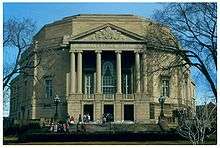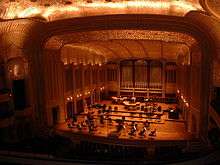Severance Hall
 | |
| Address |
11001 Euclid Avenue Cleveland, Ohio United States |
|---|---|
| Coordinates | 41°30′23″N 81°36′34″W / 41.50639°N 81.60944°WCoordinates: 41°30′23″N 81°36′34″W / 41.50639°N 81.60944°W |
| Owner | Cleveland Orchestra |
| Operator | Cleveland Orchestra |
| Capacity |
Concert hall: 2,000 Reinberger Chamber Hall: 400 |
| Construction | |
| Opened | 5 February 1931 |
| Reopened | 2000 |
| Architect | Walker and Weeks |
| Website | |
|
www | |
Severance Hall is a concert hall located in the University Circle neighborhood of Cleveland, Ohio. The hall has been the home of the Cleveland Orchestra since its opening on February 5, 1931. Severance Hall is listed on the National Register of Historic Places as part of the Wade Park District.[1]
History
Prior to the construction of Severance Hall, the Cleveland Orchestra first performed in the much smaller Grays Armory in downtown Cleveland, and then moved two miles east to the Masonic Auditorium for concerts throughout the 1920s. However, both buildings were used by other groups and for a variety of different kinds of presentations. Most famously, the Orchestra twice had to arrange alternative concert locations from Grays Armory on short notice due to a scheduling conflict with a poultry exhibition . The Orchestra's administration came to recognize the advantages that having its own hall could bring to the ensemble's performances through consistent availability of such a hall for rehearsals, radio broadcasts, and other musical purposes.
After much encouragement from the orchestra's founder Adella Prentiss Hughes and its then Music Director Nikolai Sokoloff, plans for Severance Hall materialized using land offered from Western Reserve University (now Case Western Reserve University) at $1 per year and funds from public fundraising and local philanthropists. The conceiver and biggest funder of the project was industrial magnate and philanthropist John Long Severance (8 May 1863 - 16 January 1936), who donated $1 million towards development and named the hall after his recently deceased wife Elisabeth Dewitt Severance. Despite the economic difficulties of the Great Depression, construction began in 1929 and finished in 1931.

Designed by local firm Walker and Weeks, the building's exterior is transitional between Classical, and the late flowering of Classical style known as Art Moderne or Art Deco. New York sculptor Henry Hering created an art-deco sculpture for the pediment. Inside, Severance Hall is one of America's greatest Art Deco interiors. As was usual with the style, Egyptian Revival mix with inspiration drawn from Greek and Roman themes. The ceiling and pillars of the auditorium glisten with Art Deco motifs in aluminum leaf, the new material that was the darling of Art Deco designers.[2][3]
Acoustics
Some acoustic problems were soon observed in Severance Hall shortly after its opening. These were attributed in part to the use of velvet curtains for the boxes, thick carpeting throughout much of the hall, and the fact that the stage, designed for theatrical productions, had a large, sound-absorbing fly space above it. In addition, the removable stage shells created for the orchestra to play within were constructed of non-sound-reflective materials, which also allowed sound from the hall's original organ to be heard from its position above the stage's fly space. The 6,025-pipe Ernest M. Skinner organ was a massive instrument for its day, but its positioning outside the auditorium itself was something of an experiment and limited choices for addressing the auditorium's dry acoustics.
In 1958, at the instigation of Music Director George Szell, a complete acoustical redesign of the hall was undertaken. To make the auditorium more resonant, the original proscenium and blue velvet drapes were removed and the placement of carpet was reduced to a minimum. On the stage a permanent acoustical shell was built (affectionately known as 'The Szell Shell'). The new shell consisted of thick wooden walls surrounding the orchestra in a series of convex curves. The heavy wood walls were further filled with sand to heights of up to nine feet to make them less absorbent and more reflective of sound.[4] The result was a new, vibrant-sounding space which complemented the refined, brilliant sound of the orchestra under Szell's direction.
Visually, however, the severe new Modernist stage clashed with the elegant Art Deco design of the auditorium. In addition, the organ's pipe chambers were effectively sealed off from the auditorium by the new shell. This made the organ all but non-functional, its sound being transferred into the auditorium via microphones and speakers.
Changes and renovations

In 1970 the building's drive-through street-level entrance paved with tile was closed as the use of taxis and chauffeured vehicles had declined. A dining area was set up in the resulting space. Later on, one of the access corridors on the ground floor was closed off to create space for a dressing room for women orchestra members (harpist Alice Chalifoux had used her instrument case to dress in the hall's early years, when she was one of the only women in the ensemble).
Beginning in 1998, the Hall underwent an extensive two-year, $36 million restoration and expansion. The renovated building reopened in January 2000, winning the National Preservation Honor Award.[5] The project architect was David M. Schwarz. The most significant aesthetic change was the replacement of the "Szell shell" with a new acoustical shell which would combine the acoustics of the old shell with a decorative style that harmonized with the rest of the hall. The resulting new stage area, which included space for the relocation and restoration of the building's original E. M. Skinner pipe organ by Schantz Organ Company,[6] was named in honor of then Music Director Christoph von Dohnányi. The project also created a large, new street-level lobby where the drive-though (and later restaurant) once lay, opened a new restaurant in another area of the building, expanded the women's dressing room, added additional administrative office space, and expanded and refurbished many of the Art Deco design elements and details.
Use in film
Severance Hall was featured in the 1997 Harrison Ford film Air Force One. The scene during the opening credits shows a night-time military raid on the presidential palace of the leader of Kazakhstan. Severance Hall's roof, with additional architectural elements added as set-dressing, was chosen to depict the palace. During the scene, several landmarks of nearby Case Western Reserve University are visible, including the Thwing Center (the student union) and the Allen Memorial Medical Library.
A segment of the Cirque du Soleil film, The Journey of Man, was filmed in the main lobby. Shot in 1999 in IMAX, the segment Banquine, utilized the 40 foot ceilings in the Bogomolny-Kozerefski Grand Foyer.
See also
References
- ↑ Cash, Bobby , "Severance Hall Historical Site," in Teaching & Learning Cleveland , Item #564. February 2009.
- ↑ Cleveland Architecture, 1876-1976: 1876-1976, By Eric Johannesen, Western Reserve Historical Society, 1979, p. 163
- ↑ A Cleveland Legacy: The Architecture of Walker and Weeks, By Eric Johannesen, Kent State University Press, 1999, p. 195
- ↑ Kremers, Jack A. 792,000 Reverberation Times: An Acoustical Analysis of Severence Hall Cleveland, Ohio, Architronic. May 1993.
- ↑ Cleveland Landmark Wins National Preservation Award. National Trust for Historic Preservation. 2001-10-01.
- ↑ "From the Project Archives: Severance Hall, Cleveland, Ohio". Schantz Organ Company. Archived from the original on 2007-10-20. Retrieved 2010-10-02.
- Rosenberg, Donald (2000). The Cleveland Orchestra Story (1st ed.). Gray & Company Publishers. ISBN 1-886228-24-8.
- Marsh, Robert C. (1967). The Cleveland Orchestra. World Publishing Company. Library of Congress 67-22910.
- Severance Hall. Retrieved October 27, 2005.
External links
| Wikimedia Commons has media related to Severance Hall. |
